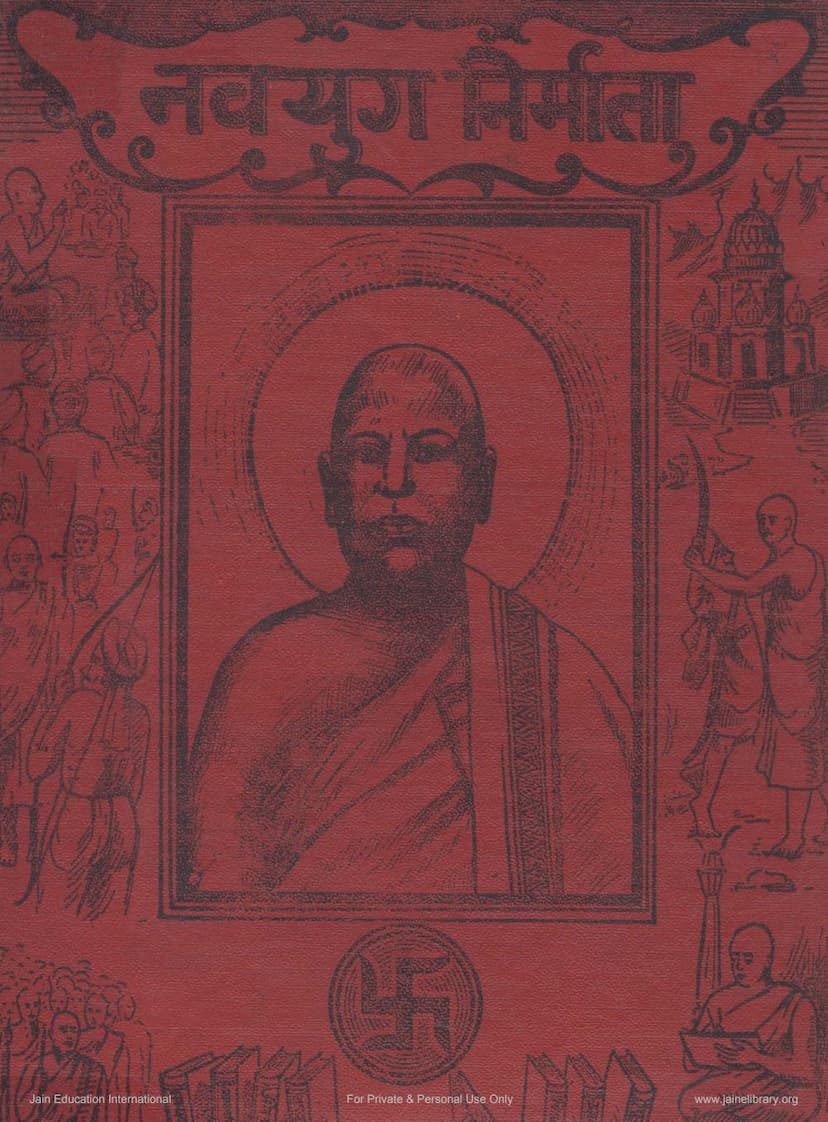Navyuga Nirmata
Added to library: September 2, 2025

Summary
Here's a comprehensive summary of the Jain text "Navyuga Nirmata" by Vijayvallabhsuri, focusing on the life of Nyayanbhonidhi Acharya Shrimad Vijayanand Surishwarji (Atmaramji Maharaj):
Book Title: Navyuga Nirmata (Builder of a New Era) Author: Acharya Shrimad Vijayavallabhsurishwarji Maharaj Publisher: Shrimad Atmanand Jain Mahasabha Punjab
Overall Theme: "Navyuga Nirmata" is a biographical account of Acharya Shrimad Vijayanand Surishwarji, popularly known as Shri Atmaramji Maharaj. The book highlights his life, his spiritual journey, his contributions to Jainism, and the profound impact he had in shaping a new era for the Jain faith. It is written by his devoted disciple, Acharya Shrimad Vijayavallabhsurishwarji Maharaj, who served as his companion for nearly 40 years. The book emphasizes the author's deep reverence for his guru and his desire to immortalize his master's legacy.
Key Figures and Relationships:
- Shrimad Vijayanand Surishwar (Shri Atmaramji) Maharaj: The central figure of the biography, described as a revolutionary saint, a beacon of knowledge, and a pioneer in reviving and re-establishing the pure, ancient traditions of Jainism.
- Acharya Shrimad Vijayavallabhsurishwarji Maharaj: The author of the book, a devoted disciple of Vijayanand Surishwarji, who chronicles his guru's life with immense love and admiration. He himself was a significant Acharya who continued the legacy.
- The Author's Relationship with His Guru: The author describes a lifelong association of 40 years, highlighting the deep affection, guidance, and inspiration he received from his guru. He attributes all his constructive work to his guru's grace and encouragement.
Narrative Highlights and Key Events:
-
Introduction and Author's Reverence: The book begins with the author's heartfelt remembrance of his guru, expressing a wish that Acharya Shri were present to see this biography. He details his long and fortunate association with his guru, starting from when he was an educator serving the Acharya.
-
Early Life and Spiritual Awakening of Atmaramji Maharaj:
- Born in the village of Lehra in Punjab in 1864 Vikram Samvat (or 1863 Gujarati Samvat).
- His parents, Ganeshchandra and Rupadevi, were devout.
- His birth name was Atmaram.
- Early signs of courage and righteousness were evident in his childhood, such as facing down dacoits with a sword and saving a mother and child from drowning.
- He was deeply impacted by the teachings of Saint Jivaramji, leading him to renounce worldly life.
- He received initiation (Diksha) at the age of 13 in 1910 Vikram Samvat in Malerkotla, becoming Muni Atmaram.
-
Quest for Knowledge and Shifting Beliefs:
- Muni Atmaramji embarked on a quest for knowledge, studying various Jain scriptures from different scholars.
- His study of Jain texts led him to question the prevailing practices of the Sthanakvasi tradition, particularly their rejection of idol worship and certain aspects of their interpretation of scriptures.
- He found discrepancies and perceived contradictions in the interpretations within his own sect (Dhunda sect).
- A pivotal influence was his encounter with Muni Ratanchandji in Agra, who, while outwardly following Dhundak practices, held liberal inner beliefs aligning more with ancient Jain traditions. Through Ratanchandji's teachings and exposure to authentic commentaries and scriptures (like Brihatkalpa Bhashya, Nishiith Chorani), Atmaramji's conviction grew that the Sthanakvasi practices were deviating from the original teachings.
- He became convinced that the core principles of Jainism, as understood by ancient Acharyas, supported idol worship and temple traditions, which his sect vehemently opposed.
-
The "Navyuga Nirmata" (Builder of a New Era) Role:
- Atmaramji Maharaj is portrayed as a reformer who challenged the established norms of the Dhunda/Sthanakvasi sect.
- He dedicated himself to reviving and re-establishing the pure, ancient traditions of Jainism, including temple worship and adherence to scriptural commentaries.
- His intellectual prowess and clear exposition of scriptures, particularly through his comparative study of Jain and Vedic philosophies, led him to write influential books like "Swami Dayanand aur Jain Dharma," "Puran aur Jain Dharma," and "Annyayavad Saur Purvapaksh."
- He actively promoted Ahimsa (non-violence) and Jivdaya (compassion for living beings).
-
Key Actions and Reforms:
- Abandonment of Mouth-Covering (Mukha-vastrika): He questioned the mandatory practice of wearing a mouth-covering (Muhapatti) at all times, arguing for its correct scriptural purpose and usage, which differed from the rigid practice of his sect.
- Advocacy for Idol Worship: His research led him to believe that idol worship was an integral part of the ancient Jain tradition, supported by scriptural references (Chaitra, Arhat Chetya) and historical evidence of ancient temples and idols.
- Challenging the Dhundak Tradition: He openly debated and challenged the Dhundak practices, asserting their deviation from the original Jain dharma.
- Initiation and Discipleship: He initiated many disciples, including prominent figures like Muni Harshvijay (former Hithisingh), Muni Laxmi Vijay (former Bishanchand), Muni Kanti Vijay (former Chamanlal), and Muni Vivek Vijay (former Ganeshilal). He also received initiation (Mantradiksha) from Muni Buddhivijay (Booteyray) in Gujarat, becoming Anandvijay, and later was bestowed the title of Acharya Shrimad Vijayanand Surishwar.
-
Literary Contributions: The book mentions several works authored or inspired by Acharya Shri, highlighting his intellectual output.
-
Impact and Legacy: Acharya Anandvijay (Atmaramji) is presented as a transformative figure who revitalized Jainism, bringing about a "new era." His efforts led to the establishment of numerous educational institutions, temples, and a resurgence of authentic Jain practices, particularly in Punjab. The author expresses deep gratitude and admiration for his guru's far-reaching influence.
Author's Perspective: The author's voice is filled with profound respect, love, and admiration for his guru. He sees his guru as a guiding light and attributes his own spiritual and intellectual growth to him. The book is not just a biography but a testament to the author's devotion and the enduring impact of Acharya Shri Vijayanand Surishwarji's teachings.
In essence, "Navyuga Nirmata" serves as a detailed chronicle of a significant Jain Acharya's life, emphasizing his role as a reformer, scholar, and spiritual leader who played a crucial part in shaping modern Jainism by adhering to and re-establishing its ancient traditions and principles.